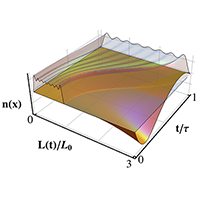Abstract
A shortcut to adiabaticity is a driving protocol that reproduces in a short time the same final state that would result from an adiabatic, infinitely slow process. A powerful technique to engineer such shortcuts relies on the use of auxiliary counterdiabatic fields. Determining the explicit form of the required fields has generally proven to be complicated. We present explicit counterdiabatic driving protocols for scale-invariant dynamical processes, which describe, for instance, expansion and transport. To this end, we use the formalism of generating functions and unify previous approaches independently developed in classical and quantum studies. The resulting framework is applied to the design of shortcuts to adiabaticity for a large class of classical and quantum, single-particle, nonlinear, and many-body systems.
- Received 6 January 2014
DOI:https://doi.org/10.1103/PhysRevX.4.021013
This article is available under the terms of the Creative Commons Attribution 3.0 License. Further distribution of this work must maintain attribution to the author(s) and the published article’s title, journal citation, and DOI.
Published by the American Physical Society
Popular Summary
The rapid compression of a gas inside a sealed container is a turbulent and dissipative event, as energy is lost irreversibly to the thermal motions of the gas molecules. When the same gas is compressed slowly, it evolves in a far more controlled manner, with negligible dissipation. This distinction is familiar to any student of thermodynamics, but it applies similarly to microscopic systems obeying the laws of quantum mechanics. When the process is slow, or adiabatic, the quantum system evolves predictably, with little or no dissipation. In recent years, there has been much interest—and progress—in developing methods for achieving controlled, dissipationless evolution of quantum systems in processes that occur rapidly rather than slowly. These methods are known collectively as “shortcuts to adiabaticity.”
This question is, in fact, of practical importance in many quantum technologies that depend on accurate and fast quantum-state control. In meeting this need, a set of mathematical tools has been developed to design such shortcuts for driven quantum systems. A particularly powerful technique among them is called “transitionless quantum driving.” The essence of this technique is to apply an additional field that effectively suppresses all excitations due to the driving. However, the mathematical complexity of computing this “counterdiabatic field” has so far severely restricted the practical applicability of the transitionless quantum driving. In this theoretical paper, we greatly broaden the scope and applicability of this technique.
Our work focuses on “scale-invariant” quantum-control processes, in which the scale of the potential energy function varies with time while its overall shape remains fixed. In particular, these processes encompass expansion, compression, and transport of matter waves. Moreover, scale invariance is particularly interesting, as it has a close analogy to classical processes. Taking advantage of this analogy and the dynamical symmetry associated with scale invariance, we have derived the general form of the counterdiabatic field required to mimic adiabatic dynamics in an arbitrary scale-invariant process and illustrated its applicability to a wide range of experimentally relevant systems.



